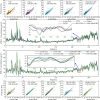Novel hybrid data-driven modeling based on feature space reconstruction and multihead self-attention gated recurrent unit: applied to PM2.5 concentrations prediction
- PMID: 40379645
- PMCID: PMC12084598
- DOI: 10.1038/s41598-025-00911-9
Novel hybrid data-driven modeling based on feature space reconstruction and multihead self-attention gated recurrent unit: applied to PM2.5 concentrations prediction
Abstract
In response to the problem of neglecting the periodic and global characteristics of sequence data when predicting PM2.5 concentrations via machine learning models, a PM2.5 concentrations prediction model based on feature space reconstruction and multihead self-attention gated recurrent unit (FSR-MSAGRU) is proposed in this study. First, the raw sequence data are subjected to frequency spectrum analysis to determine the period value of the PM2.5 sequence data. Subsequently, the seasonal trend decomposition procedure based on loess (STL) is employed to capture the periodicity and trend information in the PM2.5 sequence data. Then, the feature space of the PM2.5 sequence data is reconstructed using the raw PM2.5 sequence data, decomposed seasonal components, trend components, and residual components. Finally, the reconstructed feature data are input into multihead self-attention gated recurrent unit (MSAGRU) with the ability to capture global feature information to predict PM2.5 concentrations. Favorable prediction results were attained by the proposed FSR-MSAGRU model across 6 distinct experimental datasets, with a PCC exceeding 0.98 and a decrease in the prediction accuracy metric SMAPE of at least 68% compared to that of the GRU model. Comparative experimental results with 13 reference models demonstrate that the proposed model exhibits better prediction performances and stronger generalization abilities.
Keywords: Feature space reconstruction; Gated recurrent unit; Machine learning; Multihead Self-attention; PM2.5 concentration prediction.
© 2025. The Author(s).
Conflict of interest statement
Declarations. Competing interests: The authors declare no competing interests.
Figures










References
-
- Wu, Z. et al. Prediction of air pollutant concentrations based on the long short-term memory neural network. J. Hazard. Mater.465, 133099. 10.1016/j.jhazmat.2023.133099 (2024). - PubMed
-
- Kim, K. H., Kabir, E. & Kabir, S. A review on the human health impact of airborne particulate matter. Environ. Int.74, 136–143. 10.1016/j.envint.2014.10.005 (2015). - PubMed
Grants and funding
LinkOut - more resources
Full Text Sources

